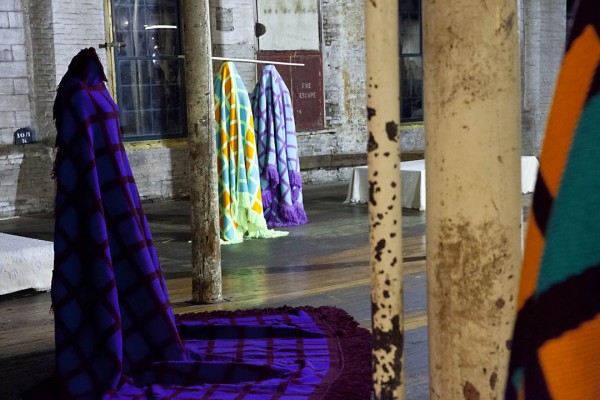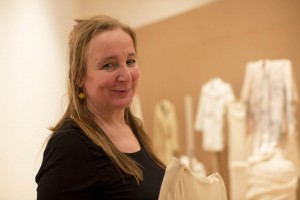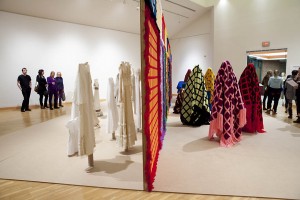Opening reception: Fransje Killaars and ‘Color at the Center’

Part of an installation by Fransje Killaars at the former Bates Manufacturing Co. Mill No. 1. Photograph by Phyllis Graber Jensen/Bates College.
If the Arts Crawl sent visitors around campus to sample a diversity of arts, and Asia Night brought a diversity of cultures to one location, the reception for Fransje Killaars: Color at the Center presented a single artist’s work in two very different places.

Dutch artist Fransje Killaars is shown during the installation of her exhibition “Color at the Center” at the Bates College Museum of Art in January. Photograph by Phyllis Graber Jensen/Bates College.
Killaars, a Dutch artist who uses textiles to create large-scale installations, is known for both a commitment to color and a propensity for crossing cultural boundaries.
At the Bates College Museum of Art, she has placed a single work that fills the main gallery (on display through March 22). Called “Figures,” and first shown in the Netherlands in 2008, it’s a two-part work divided by a high partition.
What viewers encounter first is a collection of manikins draped in Killaars’ trademark fabrics: heavily textured bedspreads that present bold colors in geometric patterns. The other part of the piece presents a sharp contrast. It’s a display of women’s clothes that represent various cultures and eras, but are largely unified by a color palette of off-whites and pale browns.
The overall power of the piece lies in its evocation of the human — specifically, female — figure. Here Killaars asks viewers to think about the ways women are depicted and the cultural roles they inhabit.

The two sides of Fransje Killaars’ “Figures,” an installation in the Bates College Museum of Art. Photograph by Phyllis Graber Jensen/Bates College.
Titled “Maine Mills Figures,” Killaars’ installation downtown is more directly site-specific. Housed in the former Mill No. 1 of the Bates Manufacturing Company, Museum L-A afforded the artist an expanse of factory floor for her work, including a central component that speaks directly to the mill’s past as the place where the well-known Bates bedspreads were woven.
Comprising the bedspread-draped manikins and low bed-shaped forms, arranged so that viewers can walk around and between them, the piece juxtaposes Killaars’ bedspreads with actual Bates-brand bedspreads, renowned for durability and the appeal of their figurative jacquard weaves.
“It was a great opportunity, because it’s such a beautiful culture,” Killaars said. “And I’m very interested in the technical side of textiles all over the world.”
Again, the artist chose to contrast the popping colors of her own work with an off-white foil, this time the Bates bedspreads. (The reception also featured a performance by Bates students interacting with the pieces.) In the mill, its structures intact and the scars and odors of long use still evident, it was tempting to try to imagine the people who spent their working lives there.
“What I like about working with textile,” Killaars said, “is that it has a relationship with daily life.”